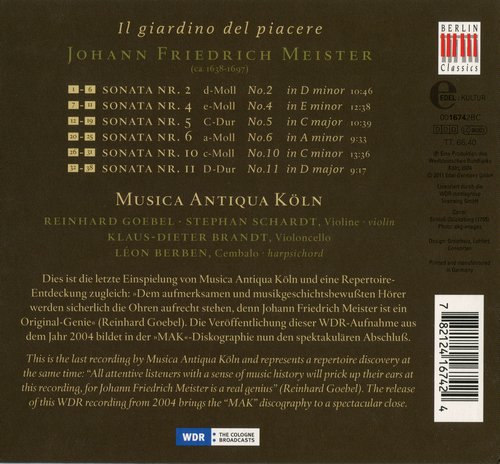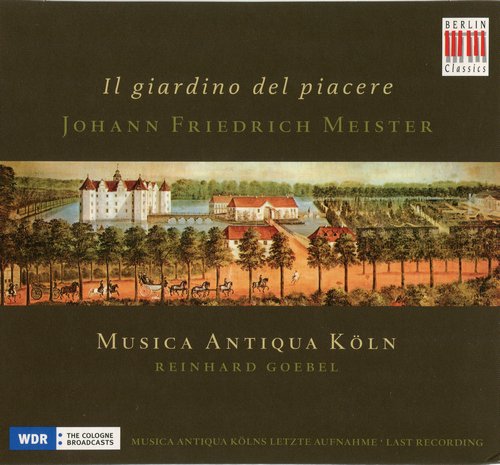
Musica Antiqua Köln, Reinhard Goebel - Meister: Il Giardino del Piacere (2011) CD-Rip
BAND/ARTIST: Musica Antiqua Köln, Reinhard Goebel
- Title: Meister: Il Giardino del Piacere
- Year Of Release: 2011
- Label: Berlin Classics
- Genre: Classical
- Quality: FLAC (image+.cue,log,scans)
- Total Time: 66:40
- Total Size: 603 Mb
- WebSite: Album Preview
Tracklist:
Sonata No.2 d-moll
1. I. Grave
2. II. Ciaccona. Allegro
3. III. Adagio
4. IV. Menuet. Allegro
5. V. (4/4)
6. VI. Gigue. Allegro
Sonata No.4 e-moll
7. I. Adagio
8. II. Fuga. Allegro
9. III. (3/2)
10. IV. Sarabanda. Adagio
11. V. Gigue. Allegro presto
Sonata No.5 C-Dur
12. I. Allegro
13. II. Grave
14. III. Adagio
15. IV. Corrente. Presto
16. V. Arioso
17. VI. Menuet. Allegro presto
18. VII. Un poco adagio
19. VIII. Gigue. Allegro
Sonata No.6 a-moll
20. I. Adagio
21. II. Menuett. Allegro presto
22. III. Adagio
23. IV. Fuga. Allegro
24. V. Adagio
25. VI. Gigue. Allegro
Sonata No.10 c-moll
26. I. Grave
27. II. Passacaglia
28. III. Allemanda
29. IV. Corrente
30. V. Sarabanda. Grave
31. VI. Gigue. Allegro
Sonata No.11 D-Dur
32. I. Allegro
33. II. Adagio
34. III. Menuett. Presto
35. IV. Adagio
36. V. Fuga. Allegro
37. VI. Menuett. Presto
38. VII. Gigue. Allegro
Performers:
Musica Antiqua Koln
Reinhard Goebel, violin
Stephan Schardt, violin
Klaus-Dieter Brandt, violoncello
Leon Berben, harpsichord

Sonata No.2 d-moll
1. I. Grave
2. II. Ciaccona. Allegro
3. III. Adagio
4. IV. Menuet. Allegro
5. V. (4/4)
6. VI. Gigue. Allegro
Sonata No.4 e-moll
7. I. Adagio
8. II. Fuga. Allegro
9. III. (3/2)
10. IV. Sarabanda. Adagio
11. V. Gigue. Allegro presto
Sonata No.5 C-Dur
12. I. Allegro
13. II. Grave
14. III. Adagio
15. IV. Corrente. Presto
16. V. Arioso
17. VI. Menuet. Allegro presto
18. VII. Un poco adagio
19. VIII. Gigue. Allegro
Sonata No.6 a-moll
20. I. Adagio
21. II. Menuett. Allegro presto
22. III. Adagio
23. IV. Fuga. Allegro
24. V. Adagio
25. VI. Gigue. Allegro
Sonata No.10 c-moll
26. I. Grave
27. II. Passacaglia
28. III. Allemanda
29. IV. Corrente
30. V. Sarabanda. Grave
31. VI. Gigue. Allegro
Sonata No.11 D-Dur
32. I. Allegro
33. II. Adagio
34. III. Menuett. Presto
35. IV. Adagio
36. V. Fuga. Allegro
37. VI. Menuett. Presto
38. VII. Gigue. Allegro
Performers:
Musica Antiqua Koln
Reinhard Goebel, violin
Stephan Schardt, violin
Klaus-Dieter Brandt, violoncello
Leon Berben, harpsichord
This album is full of surprises, not all of them associated with its musical contents. Advance PR materials stated that its contents were recorded originally for televised broadcast in 2004, then forgotten, and only just rediscovered. A final recording by the celebrated Musica Antiqua Köln, forgotten by its Read more
The music is a bit of a surprise as well, if not the result of an “original genius” that Goebel likens to C. P. E. Bach. Johann Friedrich Meister (1638–97) seems by all accounts to have been something of a rebel, getting himself imprisoned the year after his appointment as music director of the Hofkapelle of Duke Ferdinand Albrecht I of Brunswick-Lüneburg. He escaped and fled with the help of friends, and eventually ended his days with a lengthy tenure as organist at St. Marien, in Flensburg. Musically, he appears to have owed more to the earlier likes of Scheidt, Schein, and Schütz than to his immediate North German compatriots; the rapt expressiveness of his slow movements (the Adagio that opens the Sonata No. 4, the Arioso of the Sonata No. 5, the Adagio at the start of the Sonata No. 6, the Grave that begins the Sonata No. 10, to name but four outstanding examples) brings to mind the popularity of such diverse Italian composers such as Marenzio, Uccellini, Farina, and Corelli with both German musicians and publishers. Other influences would appear to be French, as in the passacaglia that is closer to the minor-key French passacaille in all respects than to the major-key Italian version.
These are the best things in the 1695 collection of sonatas—actually suites, whose movements number from five to eight per suite, and whose titles are either tempo indications or dances. There is a convincing fancy to such pieces, as well as a simple but effective craftsmanship, that makes them stand out. The three irregular fugues are ineffective as such, the new material in subsidiary voices usually perfunctory; but viewed as pieces in which imitative textures contribute instead to the twists in Meister’s musical logic, they are more successful. It’s only a shame that the rest of the sonatas weren’t recorded before MAK broke up.
The performances are persuasive. For all its reputation for laser-like intensity, Goebel’s ensemble (reduced here to four members) was also capable of warmth and theatrical sensibility—qualities that are required in these works, and supplied convincingly. The MAK’s tone is refined and disciplined, minus the choked wiriness that sometimes passes for appropriate scholarship in music of this period. Balance between the musicians is excellent, and there’s the same give-and-take you would find in good chamber groups specializing in later eras. Tempos are varied, with a slight, pleasing flexibility to phrasing that helps Meister’s Il giardino to breath. Ornamentation is light but effective, and always stylish.
With excellent sound, this album should appeal to students of the Baroque, and especially to those interested in its persuasively lyrical Italianate vein. That fanciers of the MAK will want it, goes without saying. They’d be right to do so, too. -- Barry Brenesal
The music is a bit of a surprise as well, if not the result of an “original genius” that Goebel likens to C. P. E. Bach. Johann Friedrich Meister (1638–97) seems by all accounts to have been something of a rebel, getting himself imprisoned the year after his appointment as music director of the Hofkapelle of Duke Ferdinand Albrecht I of Brunswick-Lüneburg. He escaped and fled with the help of friends, and eventually ended his days with a lengthy tenure as organist at St. Marien, in Flensburg. Musically, he appears to have owed more to the earlier likes of Scheidt, Schein, and Schütz than to his immediate North German compatriots; the rapt expressiveness of his slow movements (the Adagio that opens the Sonata No. 4, the Arioso of the Sonata No. 5, the Adagio at the start of the Sonata No. 6, the Grave that begins the Sonata No. 10, to name but four outstanding examples) brings to mind the popularity of such diverse Italian composers such as Marenzio, Uccellini, Farina, and Corelli with both German musicians and publishers. Other influences would appear to be French, as in the passacaglia that is closer to the minor-key French passacaille in all respects than to the major-key Italian version.
These are the best things in the 1695 collection of sonatas—actually suites, whose movements number from five to eight per suite, and whose titles are either tempo indications or dances. There is a convincing fancy to such pieces, as well as a simple but effective craftsmanship, that makes them stand out. The three irregular fugues are ineffective as such, the new material in subsidiary voices usually perfunctory; but viewed as pieces in which imitative textures contribute instead to the twists in Meister’s musical logic, they are more successful. It’s only a shame that the rest of the sonatas weren’t recorded before MAK broke up.
The performances are persuasive. For all its reputation for laser-like intensity, Goebel’s ensemble (reduced here to four members) was also capable of warmth and theatrical sensibility—qualities that are required in these works, and supplied convincingly. The MAK’s tone is refined and disciplined, minus the choked wiriness that sometimes passes for appropriate scholarship in music of this period. Balance between the musicians is excellent, and there’s the same give-and-take you would find in good chamber groups specializing in later eras. Tempos are varied, with a slight, pleasing flexibility to phrasing that helps Meister’s Il giardino to breath. Ornamentation is light but effective, and always stylish.
With excellent sound, this album should appeal to students of the Baroque, and especially to those interested in its persuasively lyrical Italianate vein. That fanciers of the MAK will want it, goes without saying. They’d be right to do so, too. -- Barry Brenesal

Classical | FLAC / APE | CD-Rip
As a ISRA.CLOUD's PREMIUM member you will have the following benefits:
- Unlimited high speed downloads
- Download directly without waiting time
- Unlimited parallel downloads
- Support for download accelerators
- No advertising
- Resume broken downloads


